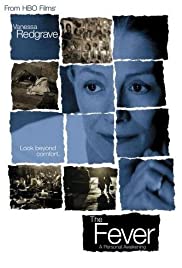
THE FEVER
US/UK, 2004, 83 minutes, Colour.
Vanessa Redgrave, Angelina Jolie, Michael Moore, Rade Sherbidja, Joeley Richardson, Geraldine James.
Directed by Carlo Nero.
This is an 80 minute drama made by Home Box Office for television release. It is an adaptation of a play by Wallace Shawn who collaborated with the director, Carlo Nero, for the screenplay. The film is very much dialogue-driven but the action opened out, filmed in various countries and locations, introducing quite a number of characters on screen, explaining what was originally a one-man show.
The film is also a star vehicle for Vanessa Redgrave in her 60s. As the audience watches the film and listens to the dialogue, they will remember Vanessa Redgrave’s own life, her political stances, her socialism, her protests, and her own personal living with her star status, her privilege, her salaries, along with her concern about poverty in the world.
The film was directed by her son, Carlo Nero, born in the 1960s – but Vanessa Redgrave and Franco Nero marrying in 2006. Also in the cast is Vanessa Redgrave’s daughter, Joeley Richardson, the director’s half sister.
Vanessa Redgrave plays a businesswoman, living a comfortable life, past relationships, growing up in London, living abroad, invited to visit other countries, especially those which resemble the Balkans during the 1990s. While she encounters a number of people and has conversations with them, a piano-playing diplomat at a party urges her to travel, scenes with her friends and neighbour at meals, a war correspondent (played, in fact, by documentary maker Michael Moore), admiring a violinist, encountering a bitter man, a seamstress, opera and ballet, watching a period play about a landowner stripped of her property. In the wartorn country, she also encounters a young woman at the church who befriends her, explains situations, that she is a rebel, that she has abandoned her two children to safe keeping so that she could continue her protests even if it means giving her life. She is played by Angelina Jolie (with whom Vanessa Redgrave had acted in Girl Interrupted).
A special feature is the use of animation at key moments and explanations.
The woman is invited to read Das Kapital and finds it difficult, but then ponders (with many visuals) the fetishism of consumerism. This challenges her life in her comfortable bubble.
But, in the latter part of the film, the character has conversations with her alter ego. In reality, she is in a hotel room, uncomfortable, complaining that chambermaid did not do her work, suffering from a fever, sitting on the floor, unable to get up. Her alter ego is a very well-dressed and urbane Vanessa Redgrave, the two of them into changing opinions, questions and challenges, especially about the rich and poor.
Issues of earning money and having a right to it (with a collage of talking heads, men and women, different ages, different ethnic backgrounds) are argued. The issue of a comfortable life, issues of responsibility for the condition of the world, for the poor, for effecting change are also important.
As the sick woman recovers and prepares to go home, the audience is left with their impression of meeting this woman, looking at her life, listening to her, experiencing her challenges and, the audience asking themselves where they stood, what they would do…
From Wikipedia: The original play was a piece of experimental theater performed as a monologue by the play's author, Wallace Shawn. Unlike conventional plays, Shawn initially performed The Fever not in a theater, but in private homes by appointment. Later, he performed the piece in a theater, but in keeping with the desire to be unconventional in presentation, Shawn eschewed theatrical lighting, sets, and theater programs, and mingled with the audience immediately before the play began. In an interview with The Paris Review, Shawn explained that he used these novel approaches to avoid people dismissing the play's message as merely "great theater."